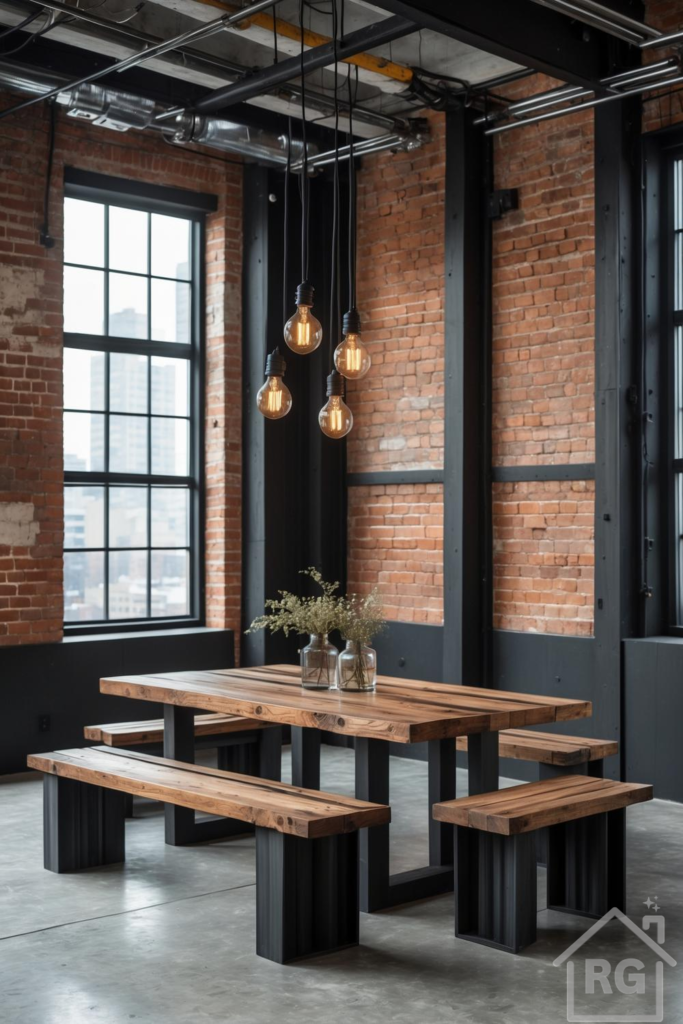
Embracing Raw Beauty: The Allure of Industrial Dining Spaces
Industrial design continues to captivate homeowners and designers alike with its honest celebration of raw materials, structural elements, and functional forms. Born from the conversion of old factories, warehouses, and industrial buildings into living spaces, this style emphasizes stripped-back architecture and utilitarian objects. The dining room featured here is a prime example of industrial chic executed flawlessly, blending rugged textures with clean lines for a space that is both imposing and inviting.
Deconstructing the Industrial Aesthetic: Key Components
Achieving an authentic industrial look hinges on successfully integrating several core elements. Let’s break down what makes this dining area work so well:
- Exposed Materials are King: The star of this space is undoubtedly the exposed brick wall, providing immediate texture, warmth, and historical character. Complementing the brick are the polished concrete floor, offering a cool, neutral base, and the prominent black metal structural beams and window frames, which add sharp, graphic lines. The ceiling reveals exposed pipes and ductwork, further reinforcing the utilitarian, unfinished feel central to the style.
- Furniture with Character: The dining set is crucial. Here, a substantial wooden tabletop, showcasing its natural grain and imperfections, sits atop robust black metal legs. The matching benches echo this design, creating a cohesive and grounded focal point. The choice of wood adds natural warmth, balancing the coolness of the metal and concrete.
- Statement Lighting: Industrial lighting often favors functionality and visibility. The cluster of pendant lights with exposed Edison bulbs is iconic to this style. Hung at varying heights, they draw the eye downward, illuminate the dining table, and add a vintage, warm glow that softens the surrounding raw materials. The black cords and simple fixtures maintain the minimalist, functional aesthetic.
- Neutral and Contrasting Palette: The color scheme relies heavily on the inherent colors of the materials: the reddish-brown of the brick, the deep black of the metal, the warm brown of the wood, and the neutral grey of the concrete. This creates a palette that is earthy yet bold, relying on contrast rather than a wide range of hues.
- Embracing Volume and Light: Industrial spaces often feature high ceilings and large windows, remnants of their original purpose. This dining room leverages a large, multi-paned window that floods the space with natural light, preventing the darker materials from feeling overwhelming and highlighting the textures within the room.
How to Recreate the Industrial Dining Vibe in Your Home
Inspired by this look? Even if you don’t live in a converted warehouse, you can incorporate elements of industrial design into your own dining space. Here’s how:
1. Introduce Raw Textures
If you have existing brickwork, expose it! If not, consider faux brick panels or even textured wallpaper for a similar effect on an accent wall. Concrete floors are ideal, but polished concrete-look tiles or even large-format grey porcelain can mimic the style. Don’t hide structural elements if you have them; paint beams or pipes in a matte black or dark grey.
2. Choose the Right Furniture
Look for dining tables and seating that combine wood and metal. Reclaimed wood offers authentic character, while dark metal bases provide the industrial edge. Think sturdy, simple lines rather than ornate details. Benches, as seen here, enhance the communal, slightly utilitarian feel, but metal chairs (like Tolix-style) or simple wooden chairs also work well.
3. Select Industrial Lighting
Lighting is key. Opt for pendant lights with metal shades, exposed bulbs (especially vintage-style Edison bulbs), or cage fixtures. Track lighting or simple black cord pendants are also effective. Consider materials like black steel, brass, copper, or galvanized metal.
4. Stick to a Muted Palette with Contrast
Build your color scheme around neutrals like grey, black, white, and brown. Use the natural tones of wood and brick as your warmer elements. Contrast is important – pair dark metals with lighter concrete or wood tones.
5. Accessorize Thoughtfully
Keep accessories minimal and functional. Simple glass vases with dried botanicals or greenery (as shown) add a touch of organic softness without detracting from the raw aesthetic. Metal storage units, vintage signs, or abstract art with bold lines can complement the look. Avoid overly decorative or fussy items.
Balancing Rawness and Comfort
While industrial design celebrates raw materials, a dining space still needs to feel comfortable and welcoming. The warmth of the wood furniture and the ambient glow from the Edison bulbs achieve this balance beautifully in the featured image. You can further enhance comfort by adding subtle textures through linen napkins or perhaps a simple, low-pile area rug under the table if the space feels too cold or echoes too much (though the bare concrete floor is very true to the style).
Ultimately, industrial design is about finding beauty in imperfection and utility. By carefully selecting materials, furniture, and lighting that emphasize texture and form, you can create a dining space like this one – full of character, history, and enduring style.
